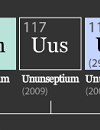
 Articles Leaders of Global Nuclear Industry to meet at World Atomic Week in Moscow First concrete poured at unit 4 at Leningrad NPP-2 National flag of Russian Federation hoisted on Yakutia nuclear icebreaker Reactor pressure vessel of Xudapu NPP Unit 4 has been installed in design position China offers the world a solution through nuclear technology applications Press Releases Construction of the first CEB Industrial Buildings as part of the Small NPP project has started in Uzbekistan The tenth anniversary AtomSkills championship completed China sets new records in the research of new-generation artificial sun HL-3 Major milestone achieved in the ITER AtomSkills-2025, the 10th Professional Skills Championship, started in Yekaterinburg | 
|
 Ununseptium - the 117th element Ununseptium - the 117th element
Physicists at the Joint Institute for Nuclear Research launched an experiment on synthesis of the 117th element in Mendeleev's periodic table.
The 113th, 114th, 115th, 116th and 118th chemical elements were first synthesized in the same institution.
All transuranium elements, starting from neptunium (93), where produced in three laboratories: in Berkley (U.S.), Dubna (USSR/Russia) and Darmstadt (Germany). USSR and USA competed in producing elements during the past century. Some elements were produced by Soviet and U.S. physicists simultaneously but separately from each other.
To synthesize ununseptium, another transuranium element, berkelium-249, is used. The experiment is carried out in a U-440 cyclotron. The synthesis process: moving at high velocity (1/10 of the speed of light), berkelium ions are ejected from a cyclotron and strike a target, where they are bombarded with calcium nuclei. Ununseptium nuclei can be discovered among the products of the reaction.
25 mg of berkelium-249 necessary for the experiment were provided by physicists from the U.S. Oak Ridge National Laboratory (ORNL).
|
|
| |
All topic news ORNL
|

Interview
Steven Kirsch
The IFR (Integral Fast Reactor) project was dead in Bill Clinton time but many
people still believe in its resurrection. The scientists and engineers from the U.S.
Argonne National Laboratory insist that their IFR/AFR concept will fully satisfy the
criteria required for the 21st nuclear reactor. Recently they win one
more supporter, Steven Kirsch.
Steven Kirsch, a multi-millionaire and business, is famous as the optical mouse
inventor and patent owner. He is a philanthropist awarding by the U.S. National
Caring Award and he was pretty agnostic about nuclear power. Now he changes
his opinion after he learnt more about the IFR.
I do not know anyone with an open mind who has met with the scientists who
worked on the project who has not come away impressed. Even the harshest critics
of the IFR admit that that they might be wrong, Kirsch writes on his website.
What are the reasons why the U.S. businessman is supporting the fast reactors?
Can the Russians and Americans cooperate in the fast reactor programs?
Last 50 news



|
|





